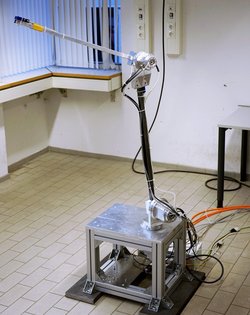- Coordinate-Invariant Modeling and Control of a Three-DOF Robot Manipulator. IFAC-PapersOnLine, Elsevier, 20217th IFAC Workshop on Lagrangian and Hamiltonian Methods for Nonlinear Control, Berlin, pp. 230-236 mehr…
Geometric Modeling and Control of Flexible Robots
Lightweight robots are a class of industrial robots characterized by a lightweight mechanical design, a high payload-to-weight ratio and specialized actuators and transmission elements. Additional sensors such as force and torque sensors allow them to be used for more dynamic, unstructured tasks and provide inherent advantages in regards to safety, which even enables direct human-machine collaboration.
A limiting factor to further optimize the mechanical design of such robots is the high mechanical stiffness that is required to achieve highly dynamic and precise motion control. The ability to compensate a certain degree of structural elasticity by appropriate modeling and control techniques can enable new mechanical designs and further reduce the robot’s weight, cost and required actuator power, while increasing efficiency and payload-to-weight ratio.
Moreover, it is advantageous to not only consider the robot itself as a mechanical system in continuous time, but also its embedding in an industrial automation environment. This suggests to adopt a discrete-time viewpoint, which makes it possible to consider the various constraints of such an environment at an early point in the modeling and control design process. Such constraints can include available computational power, sample/cycle time restrictions or dead times due to communication delays (e.g. via bus systems).
This project focuses on the problem of modeling and control of multi-link lightweight robot manipulators with structural elasticity in their joints and arms in a differential-geometric setting. The differential-geometric framework focuses on the inherent geometric structure of mechanical systems. More precisely, the configuration space of such systems has a smooth manifold or even Lie group structure, which can be exploited for modeling, analysis and control purposes. The geometric framework promises to elegantly connect the various fields that are covered by the overall topic in a structured, end-to-end approach, both in continuous and discrete time.
